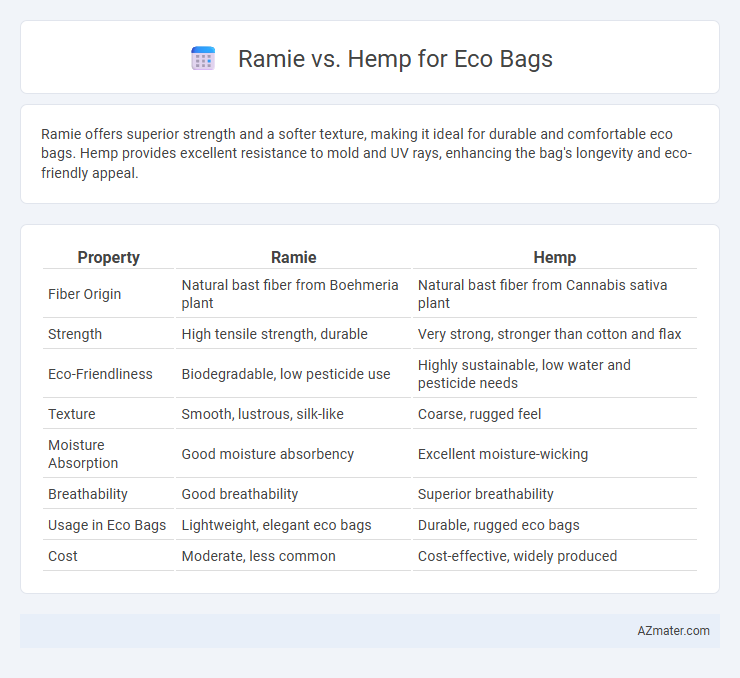Ramie offers superior strength and a softer texture, making it ideal for durable and comfortable eco bags. Hemp provides excellent resistance to mold and UV rays, enhancing the bag's longevity and eco-friendly appeal.
Table of Comparison
| Property | Ramie | Hemp |
|---|---|---|
| Fiber Origin | Natural bast fiber from Boehmeria plant | Natural bast fiber from Cannabis sativa plant |
| Strength | High tensile strength, durable | Very strong, stronger than cotton and flax |
| Eco-Friendliness | Biodegradable, low pesticide use | Highly sustainable, low water and pesticide needs |
| Texture | Smooth, lustrous, silk-like | Coarse, rugged feel |
| Moisture Absorption | Good moisture absorbency | Excellent moisture-wicking |
| Breathability | Good breathability | Superior breathability |
| Usage in Eco Bags | Lightweight, elegant eco bags | Durable, rugged eco bags |
| Cost | Moderate, less common | Cost-effective, widely produced |
Introduction to Ramie and Hemp Eco Bags
Ramie and hemp eco bags are crafted from natural fibers known for durability and sustainability, making them popular choices for environmentally conscious consumers. Ramie fiber, derived from the stalks of the Boehmeria plant, boasts a silky texture and exceptional strength, while hemp fiber, sourced from the Cannabis sativa plant, is recognized for its robustness and antimicrobial properties. Both materials offer biodegradable, reusable alternatives to plastic bags, with eco bags made from ramie providing lightweight softness and those from hemp delivering superior longevity.
Origins and Cultivation of Ramie and Hemp
Ramie, derived from the stalks of the Boehmeria plant native to East Asia, has been cultivated for over 6,000 years, thriving in warm, humid climates with ample rainfall. Hemp, originating from Central Asia, grows rapidly in a variety of climates, particularly in temperate regions, and requires minimal pesticides and water, making it a highly sustainable crop. Both fibers offer robust strength and durability, but ramie's long history of traditional hand processing contrasts with hemp's modern large-scale, eco-friendly cultivation methods.
Environmental Impact Comparison
Ramie and hemp both offer sustainable options for eco bags, but hemp has a lower environmental impact due to its faster growth rate and higher yield per acre, reducing land use and resource input. Hemp requires less water and synthetic pesticides compared to ramie, which often involves chemical retting processes that can pollute waterways. Furthermore, hemp's ability to regenerate soil and its biodegradability make it a more eco-friendly choice for environmentally conscious consumers.
Fiber Strength and Durability
Ramie fibers exhibit exceptional tensile strength, often measured at 600-960 MPa, making them highly durable for eco bag production. Hemp fibers, known for their robustness with tensile strength around 550-900 MPa, offer superior abrasion resistance and longevity. Both fibers are sustainable choices, but Ramie's higher moisture absorption can affect durability, whereas Hemp provides better resilience in various environmental conditions.
Texture and Appearance Differences
Ramie fibers produce a smooth, silky texture with a lustrous sheen, making eco bags appear sleek and slightly glossy. Hemp fibers offer a coarser, more rugged texture with a matte finish, giving bags a natural, rustic look. The tactile difference affects durability perception, where ramie's softness contrasts with hemp's sturdy, rough feel.
Processing and Manufacturing Methods
Ramie fibers undergo a labor-intensive retting process involving chemical or enzymatic treatments to extract fine, lustrous strands, which can increase production costs but yield a smooth texture ideal for eco bags. Hemp processing often relies on mechanical decortication combined with enzyme retting, resulting in durable, coarse fibers that provide strength and longevity to eco bags while supporting more sustainable, less chemically intensive manufacturing. Manufacturing methods for ramie bags emphasize fine weaving and dye absorption due to ramie's ability to hold vibrant colors, whereas hemp bags benefit from robust stitching and natural resistance to UV and microbial degradation, enhancing eco bag durability.
Biodegradability and End-of-Life Considerations
Ramie fibers exhibit exceptional biodegradability, breaking down naturally in soil within a few months, making them ideal for eco bags designed for minimal environmental impact. Hemp also offers strong biodegradability, with fibers decomposing fully in approximately 3 to 6 months under optimal composting conditions, and its durability ensures longer product lifespan before disposal. End-of-life considerations favor ramie and hemp due to their natural cellulose composition, which supports efficient composting or recycling, reducing landfill waste compared to synthetic alternatives in eco bag production.
Cost and Market Availability
Ramie fibers generally have a higher production cost compared to hemp, influencing the price of eco bags made from each material. Hemp benefits from widespread cultivation and established supply chains, making it more readily available and often more affordable in the market. Market availability of hemp-based eco bags is extensive, while ramie bags remain niche due to limited cultivation regions and higher processing expenses.
Versatility in Eco Bag Designs
Ramie and hemp fibers both offer exceptional versatility for eco bag designs, with ramie providing a silky texture and natural sheen that enhances aesthetic appeal, while hemp delivers superior durability and resistance to wear. Hemp's strong, breathable fibers allow for a wide range of bag styles from sturdy totes to lightweight pouches, making it ideal for everyday use and heavy-duty purposes. Ramie's ability to blend smoothly with other fibers supports diverse design options, combining elegance with eco-friendliness for fashionable and sustainable bags.
Choosing the Best Fiber for Sustainable Living
Ramie and hemp stand out as top eco-friendly fibers for sustainable living, with hemp offering superior durability, faster growth cycles, and natural pest resistance, making it highly efficient for large-scale eco bag production. Ramie provides a silky texture and excellent breathability but requires more chemical processing, impacting its overall environmental footprint compared to hemp. Choosing hemp for eco bags ensures a lower carbon footprint and long-lasting product quality, ideal for consumers prioritizing both sustainability and functionality.

Infographic: Ramie vs Hemp for Eco Bag
 azmater.com
azmater.com